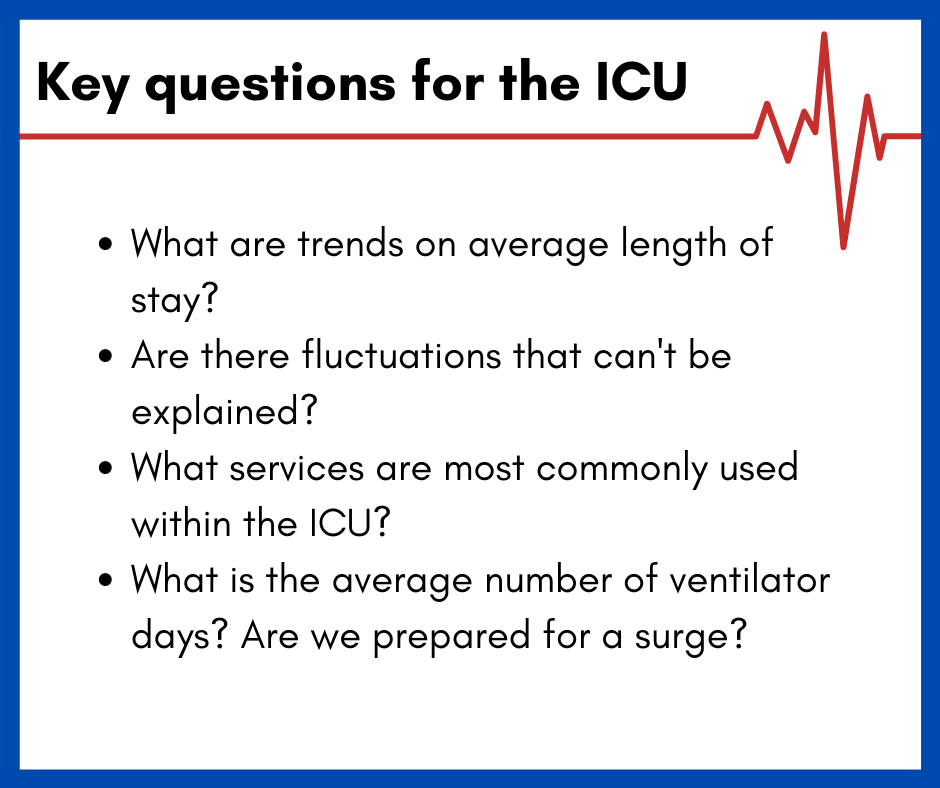There’s a renewed focus on the capacity of hospital intensive care units (ICUs), particularly those at pediatric hospitals, because of high respiratory syncytial virus (RSV) virus counts, in conjunction with the flu and COVID-19. Amid high utilization of ICUs, how can hospitals better manage their resources and staff?
ICUs have a unique set of challenges due to the acuity of patients, the types of resources needed (such as ventilators), and higher per-patient levels of staffing and necessary specializations. An analytics platform can help give insights into these challenges. Let’s take a look.
How is the department functioning operationally?
Hospital administrators need to understand how their ICU is performing at an operational level, especially at a critical time such as this. That means getting a handle on key numbers such as current census, average length of stay, average number of ventilator days, throughput statistics, and more. Understanding these numbers will help a healthcare organization determine if it is most effectively using its resources and if there are opportunities for improvement.
Analytics platforms can help ICUs see these key numbers at a balance so they can get a pulse on the state of their department at any point in time. In addition, analytics can provide a view of trends over time so administrators can answer key questions about the state of the ICU.

How is the department functioning from a financial perspective?
As with any other department in a hospital, administrators need to understand the ICU’s overall financial health and where there are areas for improvement. This includes understanding data on costs/charges per day and per stay. In addition, it’s important to understand the charges and costs of other hospital services that ICU patients are utilizing, such as imaging and pharmacy.
Analytics helps healthcare organizations visualize both overall numbers and trends over time. This enables more informed decisions, and when tied together with the operational data, helps a healthcare organization better understand its resource utilization and where it can make improvements without sacrificing quality or care.
How can the ICU make quality and outcome improvements?
Of course, the ultimate goal for any ICU is not only to improve the quality of patient care, but also to move the needle on patient outcomes.
Right now, it’s important for healthcare providers to see utilization numbers, not just from an operations efficiency standpoint, but also to understand how patient care is impacted. Is the ICU at capacity? Are we predicting a surge of patients? Does the hospital need to open additional beds to accommodate patients?
Analytics can help healthcare providers answer these questions. It can also provide a look at trends on clinical and quality measures, such as the number of central line-associated bloodstream infections (CLABSI), catheter-associated urinary tract infections (CAUTI), and sepsis, which are common infections a patient can contract in the hospital. Providers can view trends and then take steps to reduce numbers, informed by what the data is telling them.
Learn more
Dimensional Insight has an analytics application, ICU Advisor, which helps answer the questions posed above. ICU Advisor is designed as a complement to Dimensional Insight’s Hospital Operations application, and it enables healthcare providers to view and explore ICU-specific measures and KPIs.
Learn more about ICU Advisor by requesting a demo. You can also read our white paper on “How Analytics Can Help You Better Manage Your ICU.”
- Solving Hospital CEOs’ Pressing Challenges With Analytics - April 15, 2024
- Navigating the Wellness Wave: Wine & Spirits Data Strategy - April 9, 2024
- Takeaways from HIMSS24 - March 26, 2024




